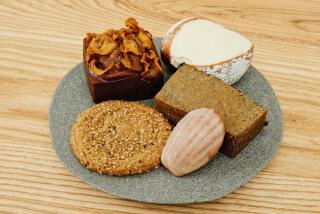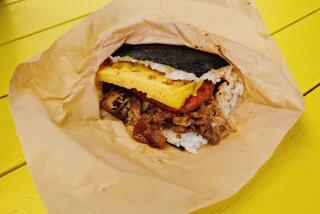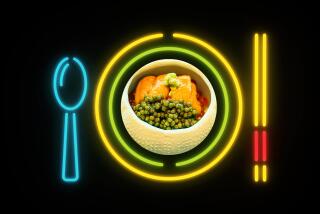Rising for Breakfast in Hong Kong : From dim sum to the thick porridge known as <i> congee,</i> the colony offers foods at many levels of price and elegance.
HONG KONG — With all the cuisines of China to choose from at dinner time, I make it a rule to eat lightly at lunch when I’m in Hong Kong. And with a full slate of things I can’t wait to do--getting to the tailor and shoemaker, selecting fine Chinese teas to take home or wandering through antique shops pining over bracelets of veined jade--lunch is usually a brief afterthought.
But breakfast is another matter. Waking up early, taking a quick swim and a leisurely breakfast, savoring the morning papers (with gratitude after the paucity of the English-language press in Japan) before the day heats up and the shops open around 9 or 10 a.m. is my idea of making the most of my precious time in Hong Kong. Since I can eat bacon and eggs, croissants and pancakes at home, I would rather savor the wealth of Chinese breakfasts available at many levels of price and elegance. Many local residents eat breakfast out, some lingering over their papers and tea as I do, some stopping for only 10 to 15 minutes before piling into trams and subways. A wide variety of eating places open as early as 7 or even 6 a.m.
Comforting and soothing to the stomach at any time of day, congee-- a thick soup made of long-cooked rice and broth, enlivened with a choice of intensely flavored ingredients added at the last minute--makes a perfect breakfast after a night of rich eating. In addition to your basic congee, served with a few pickles, perhaps a sprig or two of cilantro, with chili sauce on the side, some possible amplifications include salt pork and “thousand-year-old” eggs, pork kidneys and liver, thin slices of fresh fish and dumplings of minced chicken or pork. Ordering can easily be accomplished by pointing.
Even before turning into Burd Street, which is not far from the Western Market on a narrow alley lined with parked bicycles and carts, the fragrance of long-grain Thai rice--the favorite rice of Hong Kong--reaches me. It is 6:55 a.m. and already the small space occupied by Sang Kee is half-full of customers, mostly men in dress ranging from shorts and rubber sandals to carefully tailored Mao suits. I point to the sliced fish behind the counter and take a seat at a table under a blue and white awning outside. As I eat my congee-- the steaming bowl brought out with a small dish of soy sauce, sesame oil and slivers of scallion, ginger and cilantro, to use as condiments--I wonder who these men are who leave their homes so early to eat here. Do they live alone and seek company, or do they come to escape large noisy families in small rooms?
One of my favorite breakfasts is Shanghai style: a thick pancake filled with scallions, a long stick of dough deep-fried like a doughnut but unsweetened, or a roll of sticky rice (very filling) filled with savory bits of pickled vegetable, dried salted beef and a strip of fried dough. This is served with a bowl of hot soy milk, either lightly flavored with soy sauce or slightly sweetened (also served chilled).
There must be other Shanghai restaurants open for breakfast in the city, but I have found only one. It has the unfortunate name of Dim Sum Burger (on Cleveland Street in Causeway Bay), but don’t be discouraged. The DSB draws regular customers with its distinctive breakfast, clean white tablecloths, air conditioning and quiet, contemplative atmosphere. The menu includes English, an added grace not available in most local breakfast places.
The classic beginning to a Hong Kong day, and the one most familiar to Westerners, is dim sum. Served from dawn until late at night in eateries all over the city, small dishes of dumplings, pastries, noodles, puddings and unclassifiable delicacies can be enjoyed in surroundings ranging from opulent to basic. But the prince of dim sum palaces is without question Luk Yu Tea House & Restaurant, on Stanley Street in Central. With its marble tables, beveled mirrors, dark wood paneling, turbaned Sikh doorman and surly waiters in the New York delicatessen tradition, Luk is legendary.
Unlike most restaurants and even most dim sum parlors, where tea is supposed to be part of the ritual, Luk Yu serves reasonably good tea (which can be purchased from the Ying Kee Tea Company on Queen’s Road Central), and not only the standard assortment of dim sum (sometimes quite mediocre) but weekly specials that may soar into heavenly realms.
Although later in the day the customer is faced with a menu (in Chinese only) from which he must order, one of the nice things about breakfast is that sandaled and white-jacketed ladies periodically bring around the dim sum on metal trays laden with plates or bamboo steamers, handing them out as the customer points. Most will comply with unspoken requests to examine the goods and will lift the lids of covered dishes for inspection. An egg custard tart with flaky crust that literally dissolves on the tongue; black mushrooms stuffed with ground beef fragrant with dried mandarin orange peel; tiny spare ribs and miniature steamed buns; thin-skinned delicate dumplings of shrimp and water chestnuts with flecks of cilantro visible through the translucent skin, and cakes of a slightly-sweet pudding crunchy with water chestnuts swim through my memory.
Unless you specify the kind of tea you want the minute you sit down, you will be served jasmine tea (or po lei, a full-bodied black tea that is easy on the stomach and aids digestion of rich foods, if you are Chinese). My favorite, the precious longjin, “dragon’s well,” a delicately flavored (unfermented) green tea, is enhanced by the slightly sweet types of dim sum.
On my second visit, the tall and solemn Sikh doorman who always stands outside the lustrous wood and beveled glass doors let me into an almost-deserted Luk Yu at 7:30 a.m. The highly polished brass spittoons gleamed beside each wooden booth along the walls; the wood-paneled walls and stained glass windows glowed in readiness. But when I looked carefully, there were “reserved” notices on all tables along the walls, leaving only one row of unreserved tables down the center of the floor. A waiter came up to me and led me to the one closest to the kitchen door in the back. I indicated a wish for a seat closer to the front, and moved up two tables. I then was motioned to the table between that and the original back table. We compromised. The best way to avoid this hassle is to go to Luk Yu with someone who is a regular customer, but if you can’t arrange this, a tip of $1.50 or so, discreetly slipped into your waiter’s hand as he leads you to a table, will help in smoothing out bumps in the service.
Hong Kong must have more restaurants per capita than any place on earth. All over the city, as life stirs and traffic hums at the beginning of the day, cooks are stirring the congee , deftly wrapping dumplings and laying out soft, wide noodles on bamboo racks. Hong Kong people love to eat, and they start early. So should you.
GUIDEBOOK: Dim Sum and Then Some
Where to eat: Sang Kee: 7-9 Burd St., Central, Hong Kong; telephone locally 543-0262; open daily 6:30 a.m.-2 p.m. Breakfast: about $1.50-$2.
Dim Sum Burger, 13-15A Cleveland St., Causeway Bay, Hong Kong; tel. 577-8660 or 882-1554; open daily 7:30 a.m.-midnight. Breakfast: about $1.50-$2.
Luk Yu Tea House & Restaurant, 26 Stanley St., Central, Hong Kong; tel. 523-5464; dim sum served 7 a.m.-5 p.m. Breakfast: $7-$15.
Ying Kee Tea Company, Sin Ying Commercial Building, 151 Queen’s Road, Central, Hong Kong; tel. 544-3811; open 9:30 a.m.-6 p.m.
More to Read
Eat your way across L.A.
Get our weekly Tasting Notes newsletter for reviews, news and more.
You may occasionally receive promotional content from the Los Angeles Times.









